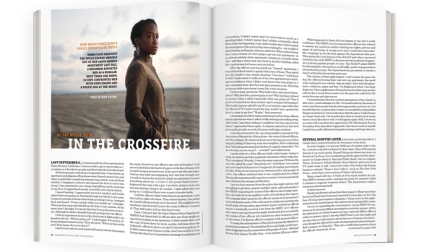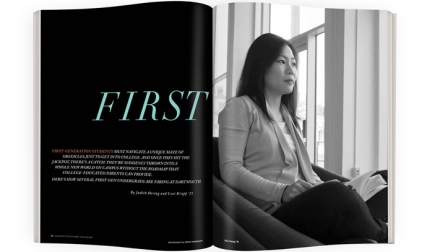The call came in at 8:23 p.m. on a warm Tuesday in Fullerton, California, a complaint not in itself exceptional. A homeless man was jiggling door handles and peering into the windows of parked cars at the city’s downtown bus depot.
When a pair of officers arrived 14 minutes later they encountered 37-year-old Kelly Thomas, shirtless and wrestling with the demons of paranoid schizophrenia. He was no stranger to police, with scores of contacts mostly limited to trespassing. Sixteen years earlier Thomas had pleaded guilty to an assault with a deadly weapon, but his record bore no other history of violence. In this encounter, Thomas, following orders, sat on a curb as officers searched his backpack.
A nearby surveillance camera provided Exhibit A for what happened next that July 5, 2011. Thomas stood at some point, making sarcastic remarks—the officers later testified he was uncooperative—and a scuffle ensued. “Now see my fists?” one officer barked. “They are getting ready to f--- you up.” Words soon melted into deadly force. The video recorded Thomas’ screams of “I can’t breathe!” Cries for his father split the night.
By now, six officers were on the scene. The Orange County district attorney reported that Thomas begged for his life as Taser probes found their target up to five times. Uniforms proceeded to strike Thomas. More than 30 minutes later he was taken to a hospital, where he lapsed into a coma and died five days later from head, face and neck injuries.
One of the millions of Americans to watch the video was Michael Gennaco, a former trial attorney for the civil rights division of the U.S. attorney’s office, where he supervised more than 20 federal grand jury investigations into police misconduct. Most of them involved force and in-custody death.
“My immediate reaction as a human was the visceral reaction that anyone would have when viewing police officers using significant force,” Gennaco says of the Thomas tape. “After viewing the video I was determined to learn more.”
And he would. As one of an estimated 100 full-time police “oversight practitioners” in the country (a self-styled appellation Gennaco has helped popularize), Gennaco has put himself squarely in the middle of a debate—emboldened by social media and no dearth of camera phones—about police force and, more to the point, excessive force.
It was at the U.S. attorney’s office that Gennaco noticed a disturbing trend in police misconduct cases. “In virtually every case I looked at, the police officer who was facing potential criminal prosecution had a prior history that had gone unaddressed or underaddressed by the agencies or sheriff’s departments that they were working for,” he says. “Some had been fired for excessive force and rehired by other departments, and because they weren’t properly disciplined or held accountable for prior misconduct, their behavior became even more egregious. There was a frustration I was feeling at the time.”
That frustration evolved into his métier. Gennaco runs the OIR Group out of Playa del Rey, California, a police auditing firm that has developed a respected niche when it comes to reviewing—and making recommendations to remedy—police use-of-force complaints.
“It’s a new field,” he notes, “and one that’s growing by significant leaps and bounds. Nothing can estrange a community from its police department more than an officer-involved shooting. The use of deadly force, while necessary, is an awesome responsibility, and when the public feels it was inappropriate or that it’s going on too frequently, it does raise significant concerns. I do think the issue has reached a crescendo over the past couple of years.”
Gennaco’s reputation preceded him when he accepted Fullerton’s invitation for an audit. From 2001 to 2014 he was chief attorney for the Los Angeles County office of independent review (OIR), a six-lawyer cohort charged with reviewing officer-involved shootings, use of force and internal affairs in the sheriff’s department.
In one notable case he scrutinized a 2005 Compton, California, incident in which sheriff’s deputies unloaded 120 rounds at an SUV whose operator had been driving erratically. The situation quickly went sideways. “The shots ended up in neighborhoods, some went into houses, one shot hit another deputy,” Gennaco recalls. “It was a tactical nightmare. The officers were in crossfire, they didn’t take cover and a grievous tragedy was narrowly avoided because the person shot at by deputies was not killed and the bullet that struck the deputy was deflected by his vest. There was no conservation of gunfire. It certainly sent the community into a tizzy.”
Twelve deputies were suspended for tactical mistakes, and Gennaco’s appraisal led then-Sheriff Lee Baca to promise better training. (In February Baca pleaded guilty to a felony charge of lying to FBI agents conducting a prisoner abuse investigation.)
“We basically gave Mike a key to our department and unlimited access to our files and personnel,” says Fullerton Police Chief Dan Hughes, who assumed his position after the Thomas incident and after the previous chief took medical leave and ultimately retired in the face of unrelenting community recriminations. “I had no hesitancy. His goal was clear: He wants to make police departments better. Mike came in with tremendous credibility.”
In the span of more than a year Gennaco studied the department’s practices and protocols. In the end his final report, released in 2012, recommended 59 changes, from regularly exposing supervisors to principles of ethics-based leadership to finding better ways to interact with the homeless and mentally ill.
Even before the document was finalized, Hughes implemented 43 reforms for his 155-officer force. The department now has four officers—no longer one—whose full-time job is to work with the city’s homeless population. Further, a county mental health clinician rides with officers to aid in interactions and direct them to help.
“When I first started as an officer 30 years ago I’d receive a call about a homeless person panhandling in front of someone’s business,” Hughes recalls. “It would then take me about two to three minutes to contact the person and get them to move. Now those same types of calls probably take our officers 45 minutes to three hours to handle because of the complexity of mental illness.”
The department also named a 14-member civilian advisory board, which meets monthly to discuss everything from body cameras to whether drones should have a place in law enforcement.
As for the officers involved in Thomas’ beating, they were acquitted of charges that included second-degree murder, involuntary manslaughter and excessive force. At the time legal experts noted that juries typically were loath to question an officer’s decisions during a confrontation with a potentially violent person.
Officer force, it turns out, does not have a postulate definition, not with more than 17,000 law enforcement agencies dotting the land. Departments in each state adhere to professional standards set forth by their own peace officer standards and training councils. It’s hardly a recipe for continuity, critics say. According to the National Institute of Justice, the research arm of the U.S. Department of Justice, “there is no single, universally agreed-upon definition of use of force.” Additionally, “there is no national database of officer-involved shootings or incidents in which police use excessive force.”
Several police agencies are working to avoid unnecessary brutality, but they represent just a sliver of the law enforcement landscape. More than 200 agencies, many of them in large cities, incorporate some form of oversight—be it enlisting the help of auditors such as Gennaco, installing police commissions or appointing civilian oversight committees. No two models are alike, says Brian Buchner, president of the National Association for Civilian Oversight of Law Enforcement (NACOLE). Since it was founded in 1995 the group has provided training to cities that want to develop citizen oversight committees.
Other departments have tried to boost accountability by equipping their officers with body cameras. (In 2014 Fullerton was the first city in Orange County to require its officers to wear cameras.) But the effectiveness of that practice is limited by its own opacity. A year-old ACLU rough estimate suggests that 25 to 30 percent of American police agencies are using the technology.
Groups such as NACOLE have to trade in anecdotal evidence, although Buchner believes the technology is a game changer. The San Diego Police Department reports that use-of-force incidents by officers dropped 46.5 percent during the course of a year as a result of officers wearing cameras. Still, much of the conversation elsewhere is built on assumptions and guesswork. “Unfortunately, research has not caught up to practice,” says Buchner, who praises Gennaco’s efforts and is optimistic about the future of oversight. “It’s not happening as quickly as I’d like to see, but there’s certainly been a sea change in terms of the federal government and private funders being willing to support this kind of work.”
Last July the White House and the U.S. Justice Department Office of Community Oriented Policing Services cohosted the President’s Task Force on 21st-Century Policing, to which Gennaco provided testimony. The group’s deliberations were an effort to help law enforcement agencies “live up to the expectations of their communities,” according to the Justice Department.
“I do think that’s a clarion call,” Gennaco says. “There will continue to be greater interest in my field and a call for more folks to do this kind of work. Police practices have been shielded from public view for a long time, and I want to provide more transparency.”
The task force effort calls for greater oversight of police departments and wider collection of data when it comes to use of force. In a letter to its co-chairs, Gennaco called for “robust” civilian oversight of police departments, while reducing force when possible. “Sometimes police officers have used force because they can, even though there may have been other ways to resolve or defuse the encounter,” he wrote.
After he graduated from Dartmouth with a psychology degree Gennaco had no sure career arc. He taught middle school and high school for several years and then enrolled at Stanford Law School because “I was looking to do public service,” he says. “I wasn’t interested in making corporations more money.”
It was in Hanover where Gennaco found a world “that I really did not know existed, having spent most of my childhood in Arizona,” he says. He particularly was influenced by an upper-level psychology course that discussed Philip Zimbardo’s recently completed landmark prison experiment. The Stanford psychology professor in 1971 used students, playing the roles of prisoners and guards, and mock prison cells to show the corruptible power of the prison system. A project that was designed to last two weeks ended after six days, after the “guards” had exacted physical and mental abuse on their charges.
“I was impacted by how easily students could assume roles as prison guards and prisoners and how facilely unchecked power could lead to abuse, principles that I regularly deal with in my current work,” Gennaco says. “Several upper-level classes also exposed me to evidence-based reasoning and analysis, again, a tenet that I continue to try to advance when dissecting and evaluating a police officer’s use of force.”
From 1994 to 2001 he was an assistant U.S. attorney in the Central District of California, where in 1995 he gained professional renown by successfully prosecuting a criminal enterprise that enslaved 72 Thai nationals in a makeshift garment factory east of Los Angeles. For many Americans the headlines were the first evidence of modern-day slavery and the criminal trafficking of human beings. Gennaco’s efforts led Congress to pass the Victims of Trafficking and Violence Protection Act of 2000, which guarantees protections for undocumented immigrants who are victims of involuntary servitude and the sex trade.
Policing the police, however, remains his craft even as oversight remains something of an anomaly in law enforcement vernacular.
Santa Maria, California, Police Chief Ralph Martin, reflecting on a more than 40-year career in the field, is to the point when he thinks back on the old—and not-so-old—days: “We didn’t have any oversight. Police overall felt they could handle everything themselves without any assistance.”
In Santa Maria, a working-class Central Coast city of more than 100,000, all of that changed in 2008. A series of officer-involved shootings in the 125-member force rocked the department and the city, capped in 2012 by an incident in which an officer shot to death another officer who was being arrested on suspicion of having a sexual relationship with a 17-year-old girl.
As in Fullerton, Santa Maria city leaders brought in Gennaco for an audit. Similarly, his report came back with a laundry list of recommendations—57, in this case—more than 50 of which Martin has enacted. Most of the criticisms dealt with inconsistent policies and a lack of best practices, including a lax attitude toward community complaints. Santa Maria has since made community outreach and data collection a priority.
“You have to collect the dots before you can connect the dots,” Martin says. “It’s important for police departments to capture proper data because when they are sued—and they will be sued—the numbers end up being their friends. Mike Gennaco helped emphasize that.” In his four decades in the Los Angeles County Sheriff’s Department, Martin says data showed that force was involved in just 1.8 percent of arrests. “That’s a pretty startling number,” he adds. “The public would think it was 50 percent.”
Martin first met Gennaco in 2005, when Gennaco reviewed all officer-involved shootings for the sheriff’s department and Martin was a division commander in its South Los Angeles station. Their paths would cross four years later and more than 150 miles to the north, where Martin was lured out of retirement to head up the beleaguered Santa Maria department. Martin wasn’t surprised by the scope of Gennaco’s audit. “The department was stuck in the 1970s,” he says.
Officers weren’t following citizen complaint protocols, instead letting criticisms go untended. Now, within 24 hours of filing a complaint, a citizen receives a letter signed by the chief promising that the matter will be addressed within 30 days. Martin believes engendering community goodwill reduces chances his department will be the next to make headlines. “We always say we’re a 911 call from being on the national news,” he says.
“Many police chiefs feel that oversight is inevitable, that if they don’t have it they will have it soon,” notes NACOLE’s Buchner, who knows Gennaco. “The more progressive chiefs understand that oversight plays an important role and that it can make their police departments more effective and build trust within the community.
“Police unions aren’t quite there yet, which isn’t to say all of them are not there,” he adds. “They are still leery of oversight. They still don’t trust that a civilian or non-sworn person has the understanding or knowledge to effectively evaluate police operations.”
Julie Ruhlin worked with Gennaco on the L.A. County OIR. With Gennaco serving as the head attorney, each of the six lawyers in the office served as an independent contractor, meaning they could ply their skills around the country. Ruhlin and Gennaco have proposed reforms to police protocol in Portland, Oregon, and Denver, as well as in cities the length of California. Last May Gennaco issued a 300-page report to the Denver Sheriff Department, criticizing it for failing to track deputy involvement in force cases. His report made 277 recommendations for improvement.
In Portland last year Gennaco challenged the police department’s rule allowing officers involved in a shooting to wait 48 hours before being questioned. The practice has been defended as an officer’s Fifth Amendment right against self-incrimination and necessary to allow time to recover from emotionally, physically and psychologically traumatic incidents. Gennaco argues the delay is inconsistent with best practices, potentially allowing an officer’s story to be colored by media coverage. The Justice Department in February met with local prosecutors and Portland city attorneys to discuss requiring officers who use deadly force to immediately file reports. The Multnomah County district attorney’s office says the practice is essential in “preserving the integrity” of criminal investigations.
Ruhlin, who at the request of the Fullerton Police Department continues to do periodic audits of that department’s use-of-force and internal affairs investigations, shares Gennaco’s zeal for law enforcement rectitude. “What I hope comes out of our work is a greater understanding by the public of how difficult a police officer’s job is, and at the same time I hope there’s a better understanding by a police agency of the public’s perspective,” she says.
To be sure, the oversight business is booming. “Police executives and city leaders are recognizing that issues they’ve maybe had for years they had better start dealing with now,” Ruhlin says. “The media and the public are paying attention now in a way they haven’t in the past.”
Gennaco is ever the pragmatist. “I often say that you’re never going to prevent unfortunate events from occurring as long as you keep hiring from the human race, but you can improve your practices so that you’re better equipped to handle them when they do,” he says. “I think out of crisis comes opportunity.”
Andrew Faught is a freelance writer. He lives in Fresno, California.




